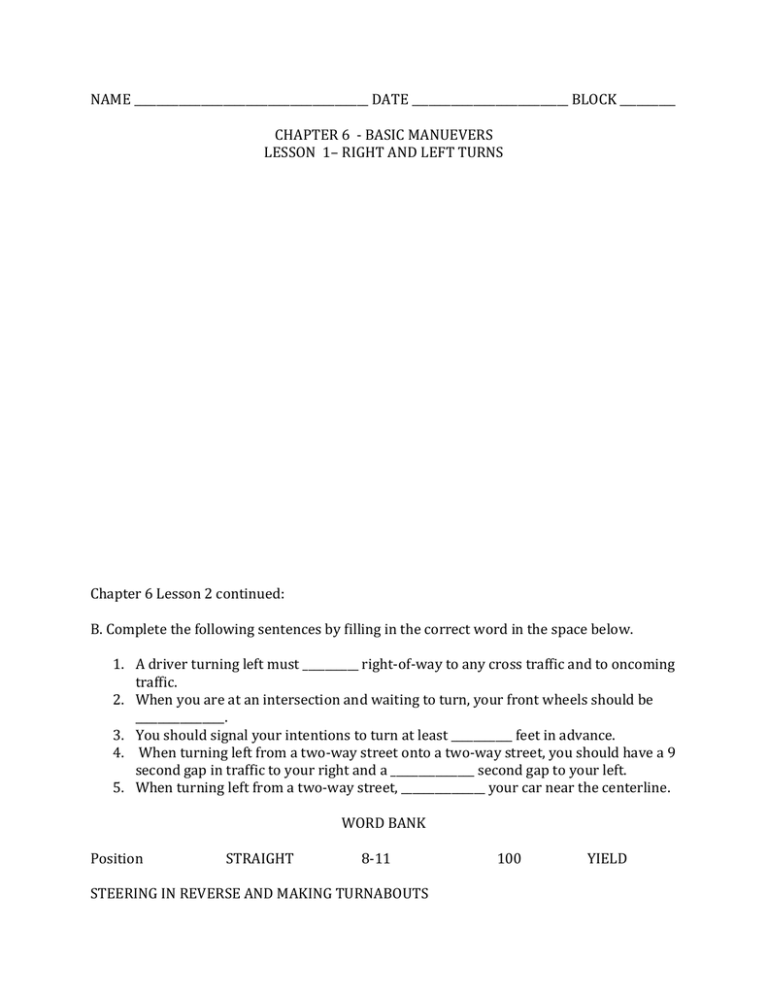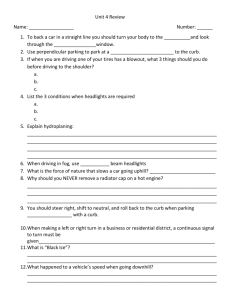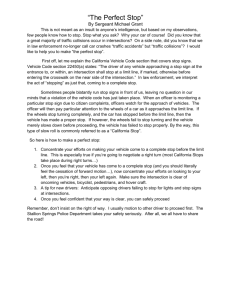NAME DATE BLOCK ______ CHAPTER 6
advertisement

NAME __________________________________________ DATE ____________________________ BLOCK __________ CHAPTER 6 - BASIC MANUEVERS LESSON 1– RIGHT AND LEFT TURNS Chapter 6 Lesson 2 continued: B. Complete the following sentences by filling in the correct word in the space below. 1. A driver turning left must __________ right-of-way to any cross traffic and to oncoming traffic. 2. When you are at an intersection and waiting to turn, your front wheels should be ________________. 3. You should signal your intentions to turn at least ___________ feet in advance. 4. When turning left from a two-way street onto a two-way street, you should have a 9 second gap in traffic to your right and a _______________ second gap to your left. 5. When turning left from a two-way street, _______________ your car near the centerline. WORD BANK Position STRAIGHT 8-11 STEERING IN REVERSE AND MAKING TURNABOUTS 100 YIELD Chapter 6 Lesson 3: TRUE OR FALSE: Correct each false statement. 1. The safest turnabout is the three-point turn. 2. You should have at least 500 feet of visibility before you do a turnabout. 3. A three-point turn should be made when the street is narrow and there are no driveways to turn in. 4. A good location for a three-point turn is on a curve. 5. Driving around the block id often the easiest turnabout to make. 6. U-turns may not be legal in all areas. 7. You should not make a turnabout within 100 feet of an intersection. 8. A two-point turnabout heading into a driveway on the right is considered dangerous. PARKING: Chapter 6 Lesson 4: TRUE OR FALSE: Correct each false statement. 1. Angled parking spaces are set an angle of 30 to 90 degrees to the curb or line. 2. When angle parking, stay at least 10 feet away from parked vehicles to give yourself room to maneuver. 3. To parallel park, you need a space at least 10 feet longer than the length of your vehicle. 4. It is a good idea not to park your vehicle next to a poorly parked vehicle. 5. When parking downhill at a curb, park your vehicle with the wheels turned sharply to the left. 6. When parking your vehicle downhill, leave it in neutral is it has manual transmission. 7. When parking uphill next to a curb, park your vehicle with the wheels sharply to the left. 8. If you are parking your vehicle uphill where there is no curb, your wheels should be turned sharply to the left. SAFE DRIVING PROCEDURES FOR PASSING AND BEING PASSED Chapter 6 Lesson 5: TRUE OR FALSE: Correct each false statement. 1. You should not pass another vehicle in heavy fog. 2. You typically need to accelerate 25 miles per hour faster than the vehicle ahead of you if you are passing it on a two-lane highway. 3. You should exceed the speed limit only when passing a vehicle on a two-lane road. 4. If you are driving a vehicle at 50 MPH, it will take you about 6 seconds to pass another vehicle that is going 40 MPH. 5. You should signal your intent to return to the right lane when passing a vehicle after you see both headlights in your side view mirror. 6. It is illegal to accelerate when you are being passed by another vehicle.






